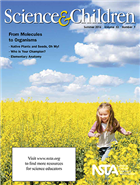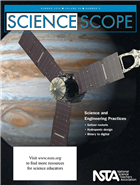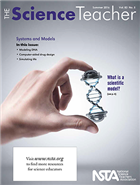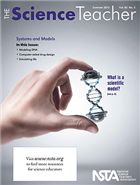Ideas and information from NSTA's Summer K-12 journals
By Mary Bigelow
Posted on 2016-07-24
These issues are great additions to your summer reading list! Most of the lessons in these journals include a detailed chart connecting the lesson to the NGSS.
 Science and Children – From Molecules to Organisms
Science and Children – From Molecules to Organisms
The featured articles focus on developing a progression of learning for younger students.
- Native Plants and Seeds, Oh My! – Using a plant found in the school garden (milkweed), this lesson includes several parts on the basics of plants and investigations with native plants. Photographs show students at work.
- Who Is Your Champion? – With a focus on designs and models, students consider the question “What can we learn from plants and animals to help solve the problems we face in our lives?”
- Stalk It Up to Integrated Learning – Plant parts as food is the basis for this set of learning activities.
- Elementary Anatomy – Young students enjoy learning about themselves. This lesson for preschool students helps students learn about body parts they can’t see.
- Learning About Plants With STEAM – This year-long project incorporates the arts and sciences, using plants in an outdoor garden as a focus.
- Teaching Through Trade Books: The Purpose of Individual Parts and Processes – These two 5E lessons help K-2 and 3-5 students understand life cycles and the purposes of different parts of an organism.
- Formative Assessment Probes: Big and Small Seeds – Probes such as this one can be used in developing student understanding of science and engineering practices.
- The Early Years: Discovering Through Deconstruction – Students can learn from taking things apart to go from the whole to its parts. This lesson for young children deconstructs a fruit to learn about plant parts.
- Making the Transition to Three-Dimensional Teaching – Using the EQuIP rubric can help evaluate resources and align them to the NGSS.
- Science 101: Q: How Do We Distinguish Between Living and Nonliving Things? – This article for teachers has thoughts on this deceptively simple question.
For more on the content that provides a context for these projects and strategies see the SciLinks topics Butterflies, Characteristics of Living Things, Factors Affecting Plant Growth, Invasive Species, Life Cycles, Plants as Food, Plants with Seeds, Seed Germination, Structure of Seed Plants.
Continue for Science Scope and The Science Teacher
 Science Scope – Science and Engineering Practices
Science Scope – Science and Engineering Practices
As you read the articles, take note of how the learning activities address science and engineering practices:
- Asking questions (for science) and defining problems (for engineering)
- Developing and using models
- Planning and carrying out investigations
- Analyzing and interpreting data
- Using mathematics and computational thinking
- Constructing explanations (for science) and designing solutions (for engineering)
- Engaging in argument from evidence
- Obtaining, evaluating, and communicating information
- Evaluating the Egg Drop: Using the EQuIp Rubric to Ensure Activities Meet the Next Generation Science Standards – See how a teacher updated a lesson to incorporate the three dimensions of NGSS, increasing student interest at the same time.
- Tried and True: Falling in Style – This 5E lesson is a variation on the egg-drop investigation, in which students design and test parachutes while learning about air resistance and gravity.
- WISEngineering Hydroponics: A Technology-Enhanced, Life Science Engineering Design Unit – Using the WISEngineering simulation, www.wisengineering.org students design a system for growing plants without soil. The article includes photographs of the projects and screenshots of the simulation.
- Engineering Technology for the Digital World – Students are very familiar with technology, but do they understand how their devices work? This activity introduces them to the binary system as they build and text a circuit board.
- Engineering Seltzer Rockets – Rather than expensive model rocket kits, students use simple materials to design and test rockets. This enables them to explore variables and conduct multiple tests.
- Bone Tissue Engineering: An Interactive Engineering Design Module – To address a real-world situation, students become biomedical engineers as they design and test a cranial mesh implant
- Teacher’s Toolkit: The New Standard in Technology Education: 3-D Design Class – Students get excited about using new technology, but the des
ign process is just as important as the technology. The authors note that “In order to benefit from 3-D printing technology in the classroom, students need to build a skill set in 3-D modeling” and include an outline of the process (see The Science Teacher for more on modeling.)
For more on the content that provides a context for these projects and strategies see the SciLinks topics Biomedical Engineer, Cellular Respiration, Force of Gravity, Forces and Motion, Hydroponics, Newton’s Laws, Photosynthesis, Skeletal System.
 The Science Teacher – Systems and Models
The Science Teacher – Systems and Models
Students and parents often have a misconception of scientific models. The editor notes that “art projects, physical replicas, posters, and diagrams are not really scientific models, although they can be valuable learning experiences. ….a true model must be useful to explain natural phenomena and make predictions.”
- Crafting a Masterpiece – The author shares his experiences in using the EQuIP rubric to redesign lessons.
- Modeling DNA – Among other activities in this 5E lesson, students position their bodies to create a DNA model; they also use other materials to illustrate the structure and function of DNA.
- Explaining Ramps With Models – The authors described how this approach to learning resulted in more in-depth understanding. They include design strategies and photographs to illustrate student work.
- Computer-Aided Drug Design – Computers have enhanced the modeling process. Find out how students took on the role of “medicinal chemist” and used software simulations focused on cancer drugs to see the relationship between chemistry and biology.
- Simulating Life – This article looks at the emerging field of biomodeling. Students use simple materials (e.g., dice) and mathematics to analyze and predict bacteria movement.
- Connecting the Visible World With the Invisible – Throughout the year, students created and used particulate diagrams to represent their knowledge of elements, mixtures, and compounds.
- Science 2.0: Soaring in a Digital Ecosystem – The authors describe a taxonomy of technology processes: substitution, augmentation, modification, and redefinition. The latter two are part of how technology can transform a classroom.
- Focus on Physics: The Equilibrium Rule—A Personal Discovery – Here’s a refresher on the topic, with illustrations and examples.
For more on the content that provides a context for these projects and strategies see the SciLinks topics Acceleration, Balanced and Unbalanced Forces, Compounds, DNA Structure and Function, Elements, Equilibrium, Mixtures, Motion, Velocity
These issues are great additions to your summer reading list! Most of the lessons in these journals include a detailed chart connecting the lesson to the NGSS.
 Science and Children – From Molecules to Organisms
Science and Children – From Molecules to Organisms
Soaring in a Digital Ecosystem
By sstuckey
Posted on 2016-07-21
This column regularly describes digital tools to help teachers make learning more personal and effective for all students. When these tools converge, they create a sort of digital ecosystem designed to make students more collaborative and innovative, skills essential for success in today’s world. But are your students truly using digital technology to its maximum benefit?
The SAMR model
Our efforts toward digital convergence are based on the Substitution  Augmentation Modification Redefinition (SAMR) model (http://bit.ly/1mFgc1l) (see box), which leads to higher-order technology in the classroom. Used at a low level, technology merely serves as a substitution—for example, using a word processor instead of paper and pencil to write a conclusion.
Augmentation Modification Redefinition (SAMR) model (http://bit.ly/1mFgc1l) (see box), which leads to higher-order technology in the classroom. Used at a low level, technology merely serves as a substitution—for example, using a word processor instead of paper and pencil to write a conclusion.
The next level is augmentation, in which technology improves on a learning task similar to what students could do without the technology, such as using the formatting tools in a word processor to highlight areas of interest. Much of classroom technology falls into these two categories, including scientific probes and graphing calculators (www.desmos.com). Our goal is to move on to the next levels of technology use: modification and redefinition of student work to demonstrate understanding.
Getting to Modification and Redefinition
To help you look at your lessons through a SAMR lens, let’s put a sample activity—a traditional chemical reactions experiment—through the SAMR continuum. First, students might use technology to substitute for an analog tool, such as using an online stopwatch (e.g., www.online-stopwatch.com)—instead of an actual stopwatch to time a reaction. To compare the physical and chemical properties of compounds being used in their reactions, students might substitute online reference guides (e.g., www.webelements.com, www.chemicalelements.com) for the paper periodic tables crammed into their backpacks or binders.
The next step up, augmentation, includes tools that give students time to analyze data rather than merely collecting it. Examples include using graphing software (e.g., https://plot.ly/plot, www.onlinecharttool.com and www.chartle.net) and data-collecting probes (such as those found at www.pasco.com and www.vernier.com) to quickly gather data about the chemical reactions so students can focus on describing the reorganization of matter in their products to evidence learning.
Traditionally, we may have asked students to complete a worksheet with data tables and analysis questions, a task that could be substituted by an online Google Doc or Form. But now we can modify this task—advancing to the next level—by asking students to create a podcast (using, for example, http://vocaroo.com) that describes what they saw as the chemical reaction occurred. We could also ask them to video (using, for example, www.wevideo.com or www.magisto.com) what they saw, narrating in voiceover how bonds are breaking and new ones are being formed. With the right device, they could even mark up that video (using, for example, www.coachmyvideo.mobi or www.coachseye.com). Turning in such an assignment could be as simple as sharing a URL or dropping a file into a shared folder (e.g., https://apps.google.com, www.dropbox.com).
But why not completely redefine how student work is assessed and evaluated by asking students to critique each other’s work (https://voicethread.com) and extend the thinking of the student who created it? This type of collaboration and discussion, previously only available in text-based discussion boards, allows students to build and grow their learning network and share their innovative products with peers in a meaningful way.
Conclusion
Digital convergence really means increased engagement and higher-order thinking in our students. Look at the technology available in your own classroom and ask whether students are using it to reach new heights in their learning.
Ben Smith (ben@edtechinnovators.com) is a physics teacher in Red Lion, Pennsylvania; and Jared Mader (jared@edtechinnovators.com) is the director of technology for the Lincoln Intermediate Unit in New Oxford, Pennsylvania. They conduct teacher workshops on technology in the classroom nationwide.
Get Involved With NSTA!
 Join NSTA today and receive The Science Teacher, the peer-reviewed journal just for high school teachers; to write for the journal, see our Author Guidelines and Call for Papers; connect on the high school level science teaching list (members can sign up on the list server); or consider joining your peers at future NSTA conferences.
Join NSTA today and receive The Science Teacher, the peer-reviewed journal just for high school teachers; to write for the journal, see our Author Guidelines and Call for Papers; connect on the high school level science teaching list (members can sign up on the list server); or consider joining your peers at future NSTA conferences.
The mission of NSTA is to promote excellence and innovation in science teaching and learning for all.
Future NSTA Conferences
5th Annual STEM Forum & Expo, hosted by NSTA
- Denver, Colorado: July 27–29
2017 Area Conferences
- Baltimore, Maryland: October 5–7
- Milwaukee, Wisconsin: November 9–11
- New Orleans, Louisiana: November 30–December 2
National Conferences
- Los Angeles, California: March 30–April 2, 2017
- Atlanta, Georgia: March 15–18, 2018
- St. Louis, Missouri: April 11–14, 2019
- Boston, Massachusetts: March 26–29, 2020
- Chicago, Illinois: April 8–11, 2021
Follow NSTA
This column regularly describes digital tools to help teachers make learning more personal and effective for all students. When these tools converge, they create a sort of digital ecosystem designed to make students more collaborative and innovative, skills essential for success in today’s world. But are your students truly using digital technology to its maximum benefit?

